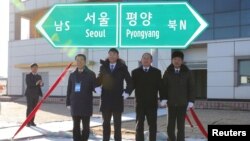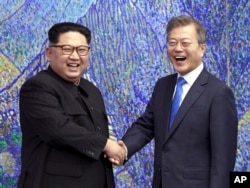North and South Korea held a groundbreaking ceremony Wednesday to mark the start of a joint project to connect railways throughout the divided peninsula. The event was held after both Korea’s inspected railways along the peninsula’s east coast.
Ministry of Foreign Affairs Special Representative for Korean Peninsula Peace and Security Affairs Lee Do-hoon told reporters last week, “The railroad linkage project and related groundbreaking ceremony were given the go-ahead to proceed as scheduled in the working group today,” referring to meetings held with State Department Special Representative for North Korea Policy Stephen Biegun in Seoul.
Jung Dae-jin, a research professor with the Ajou Institute of Unification called the ceremony a strong indicator of both North and South Korea wanting to continue discussions held by South Korean President Moon Jae-in and North Korean leader Kim Jong Un this year.
“It looks frozen water from the surface, but the potential of having those conversations is still alive, like the water flowing beneath the ice,” he said.
Jung added that as the North’s rail and roadways are improved, “it can reduce the traveling time which encourages exchanges” between the two governments.
A special train carried 100 South Korean officials, politicians and members of families displaced by the war to the ceremony at Panmun Station in the border city of Kaesong.
In addition to officials from the United Nations, China, Russia, and Mongolia, South Korea’s unification ministry said they were joined by North Korea’s delegation of 100 people.
Following Wednesday’s ceremony, North and South Korea agreed to undertake further railway inspections and work closely with the United States and the United Nations to garner further support for the project and to address sanction concerns.
Railways and sanctions
North Korea’s rail system is said to be antiquated and in desperate need of repair in order to be linked with the South’s. During the first inter-Korean summit in April, North Korean leader Kim Jong Un and South Korean President Moon Jae-in agreed to "modernize" and "connect" the roads and railways across their border as part of efforts to improve ties and promote development and prosperity.
The railway inspection project had been delayed for months amid concerns about possible violations of UN sanctions on North Korea, but the project was given the go-ahead when the UN Security Council granted a sanctions exemption.
Professor Jung recalls that connecting the North’s and South’s rail lines were part of the 2000 Joint Declaration made by Seoul and Pyongyang and between 2007 and 2008, trains traversed the border several hundred times.
But, “if the extra sanctions are not lifted in the future, the whole plan of modernizing North Korea’s railroad will not be possible too,” he said.
Jung ties the future success of President Moon’s initiatives and plans for the connected railway to North Korea’s denuclearization.
“We need to see the New Year’s address by Kim Jong Un,” he said and notes that it is necessary that the global community see concrete measures taken by Pyongyang toward denuclearization for the process of rail and roadway use to proceed.
Lee Ju-Hyun contributed to this report.













